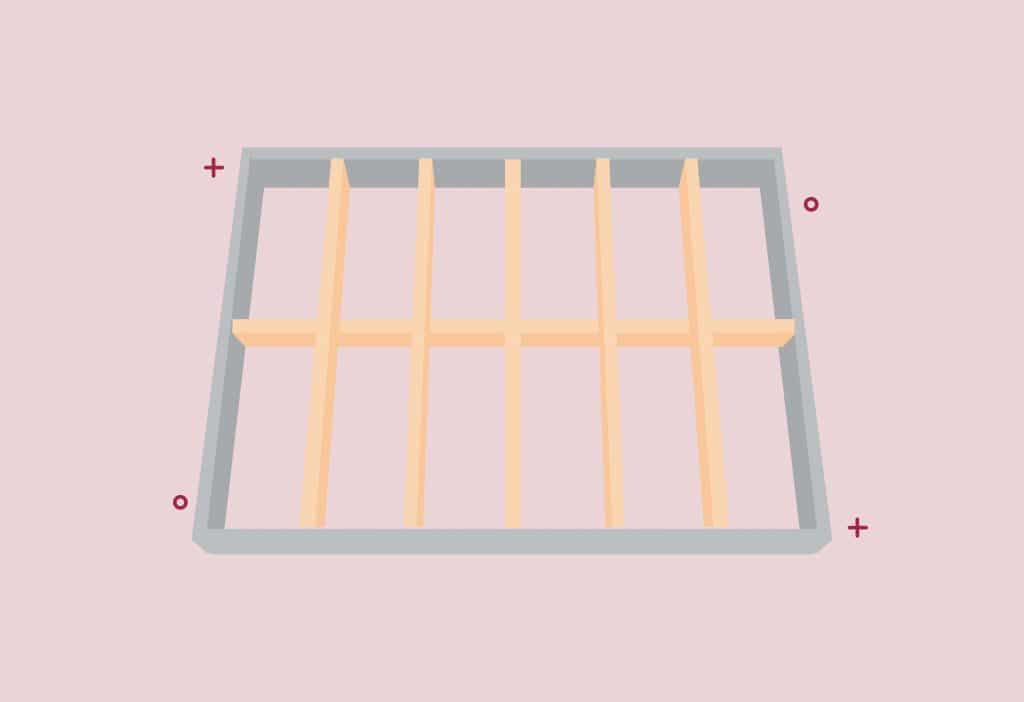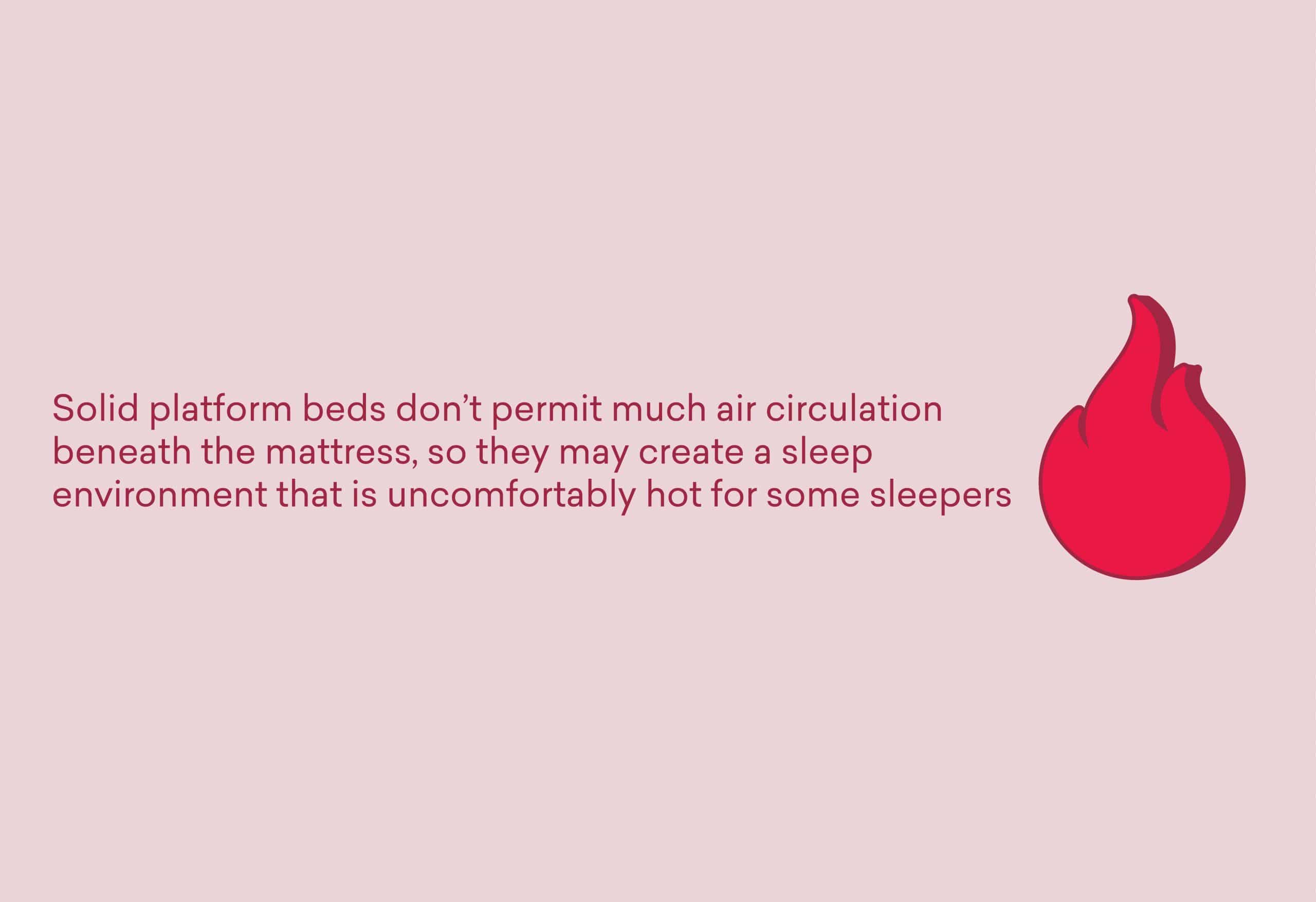What is a Platform Bed? Pros and Cons

Key Takeaways
- Platform Bed Attributes: Platform beds are low-profile, raised frames that support a mattress without the need for a box spring. They are typically 5 to 12 inches in height and can include additional features such as a headboard, footboard, and storage drawers. Platform beds are known for their affordability, ergonomic design, and suitability for small bedrooms or apartments with limited storage space.
- Benefits and Drawbacks of Platform Beds: Platform beds offer advantages such as affordability, flexible comfort adjustment, and improved mattress breathability. However, they may not be suitable for seniors or individuals with asthma due to their low height. Additionally, their firmness and lack of air circulation may not be ideal for those who prefer a softer sleeping surface or cooler sleep environment.
- Types of Platform Beds: There are various types of platform beds available, including slatted, metal, and solid platform beds. Slatted platform beds offer adjustable slats for customized comfort and enhanced air circulation, while metal platform beds provide additional mattress support and durability. Solid platform beds have a flat surface without slats, making them a good option for heavier sleepers.
There are quite a few bed styles available in the marketplace today, and the platform bed is a popular choice because it provides sleepers with support, flexibility, and better ventilation for the mattress. Let’s take a closer look at the basic attributes of the platform bed, as well as the specific types of platform bed that you may want for your own bedroom.
What is a Platform Bed?
Also known in the industry as a cabin bed, the platform bed is a low-profile, raised frame that supports a mattress. Platform beds generally sit lower to the ground compared to most traditional bed frames and box springs, and platform beds are usually between 5 to 12 inches in height.
One of the most notable features of the platform bed is that they allow owners to sleep comfortably on their mattress without the use of a box spring or separate foundation. Platform beds can also contain a headboard, footboard, and additional storage drawers under the bed or at the foot of the bed.
Like standard bed frame sizes, platform beds are designed to accommodate common mattress sizes.
Platform Bed Benefits
Platform beds offer sleepers a wide range of benefits. First and foremost, platform beds are affordable and ergonomic compared to other beds. They’re also fairly compact and ideal for small bedrooms or apartments with limited storage space.
Slatted platform beds offer flexible comfort adjustment, as the slats can be moved to better accommodate specific sleeping preferences. These same slats also allow for better mattress breathability and airflow. On the flip side, solid platform beds are better for accommodating sleepers with heavier body weight.
Platform Bed Drawbacks
Because platform beds are lower to the ground, they may not be ideal for seniors or people with asthma. Platform beds are also generally heavier and harder to move and relocate compared to other beds, so they might not be a great option for people who relocate frequently or people who like to reconfigure their bedrooms often.
In general, platform beds may be too firm for sleepers who prefer a soft, contouring sleeping surface. Also, solid platform beds don’t permit much air circulation beneath the mattress, so they may create a sleep environment that is uncomfortably hot for some sleepers.
Types of Platform Beds
Slatted Platform Bed
Instead of using a solid surface foundation, the slatted platform bed consists of a frame with side rails to support multiple slats which provide the base for your mattress. These slats are typically adjustable to match specific sleeping preferences. For example, the slats can be moved farther apart to increase the give and softness provided by the new bed, or the slats can be moved closer together to increase the firmness and support of the mattress.
Slatted platform beds provide excellent air circulation for your mattress, ensuring a comfortable and cool sleep environment. Most slatted platform bed models are very affordable, though they may not accommodate every type of mattress.
Metal Platform Bed
The metal platform bed consists of a metal frame with rigid secondary steel and support wire which form a grid-like layout to support the mattress. Metal platform beds offer additional support for your mattress than most slatted platform beds, and they often last longer and provide better resistance to everyday wear and tear. Most metal platform beds can support a traditional box spring although it’s not necessary, and due to the stronger materials, metal platform beds are almost always more expensive than slatted platform beds.
Solid Platform Bed
Unlike the slatted and metal platform beds, a solid platform bed consists of a solid, flat surface (usually wooden or laminate) that supports your mattress. This version of the platform bed does not use slats and generally sits lower to the ground than slatted and metal platform beds.

FAQs
Can I pair a box spring with a platform bed?
Box springs and platform beds serve a similar purpose, so they are not typically not paired together. However, some platform bed varieties can be paired with a box spring if you prefer a higher bed. Be sure to read the specific instructions that come with your platform bed to see if it can support a box spring.
Can I pair a bunkie board with a memory foam mattress?
Yes, it’s generally recommended to pair memory foam mattresses and hybrid mattresses with a bed that utilizes a solid base. While it would be better to pair your memory foam mattress with a bunkie board than a box spring, a mattress foundation would also work and provide all of the support your memory foam mattress requires.
What’s the difference between a platform bed and a mattress foundation?
A mattress foundation consists of a wooden box with a slatted frame for enhanced firmness and sturdy support. Mattress foundations are generally covered with a breathable fabric and they support most mattress types. Unlike a platform bed, the mattress foundation won’t have a headboard or footboard, and it won’t have any storage compartments.
The right bed base for you will depend on your mattress type and how high you want your mattress to sit.
What’s the difference between a platform bed and a futon?
There are certainly some similarities between the platform bed concept and a futon, but the primary difference is that futons serve as both a bed and a couch, and they’re also fully foldable whereas platform beds serve strictly as beds and are not foldable.
What is a euro-style slat system?
This term refers to the layout of slats in a slat platform bed. The euro-style slat system utilizes dual-sided, flexible wooden slats and a wooden frame. These flexible slats will rotate under pressure in response to the position and weight of your body for greater comfort.
Conclusion
Platform beds are great because they don’t require the use of a box spring like other traditional bed frames. They’re a great option for smaller apartments and studios with limited storage space, and while the slatted platform beds offer enhanced comfort flexibility, the solid and metal versions are better for heavier sleepers who need a strong base. If you’re in the market for a new platform bed, be sure to choose the right one for you and your partner for a better night of sleep.
This article is for informational purposes and should not replace advice from your doctor or other medical professional.
James Nguyen, Sleep Expert 
James Nguyen is Zoma's resident sleep expert and staff writer. James enjoys learning about the newest technologies in the mattress industry and doing deep dives into the science of sleep. He's tried nearly every gadget and gizmo in an effort to determine which sleep-promoting accessories can truly enhance your shut-eye. Outside of work, James takes his dedication to get healthy sleep seriously, and has even declared himself an "expert napper." James' research has been featured on Thrive Global and other media.
View all posts

